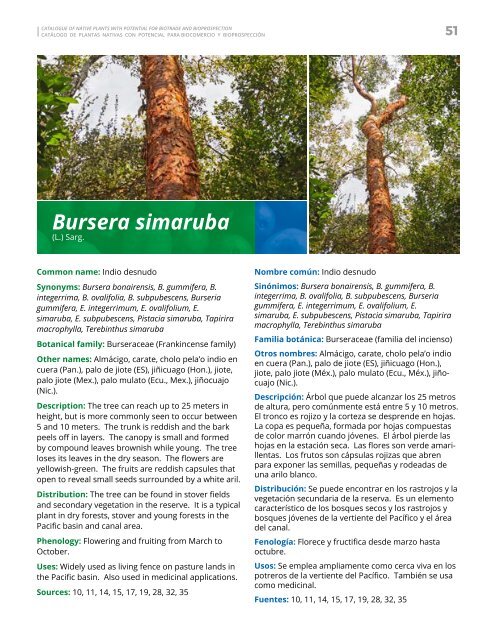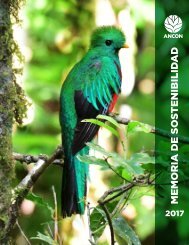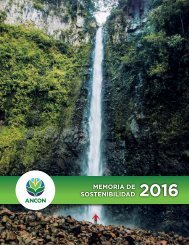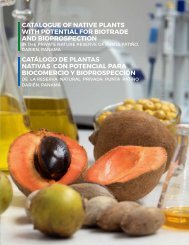You also want an ePaper? Increase the reach of your titles
YUMPU automatically turns print PDFs into web optimized ePapers that Google loves.
CATALOGUE OF NATIVE PLANTS WITH POTENTIAL FOR BIOTRADE AND BIOPROSPECTION<br />
CATÁLOGO DE PLANTAS NATIVAS CON POTENCIAL PARA BIOCOMERCIO Y BIOPROSPECCIÓN<br />
51<br />
Bursera simaruba<br />
(L.) Sarg.<br />
Common name: Indio <strong>de</strong>snudo<br />
Synonyms: Bursera bonairensis, B. gummifera, B.<br />
integerrima, B. ovalifolia, B. subpubescens, Burseria<br />
gummifera, E. integerrimum, E. ovalifolium, E.<br />
simaruba, E. subpubescens, Pistacia simaruba, Tapirira<br />
macrophyl<strong>la</strong>, Terebinthus simaruba<br />
Botanical family: Burseraceae (Frankincense family)<br />
Other names: Almácigo, carate, cholo pe<strong>la</strong>’o indio en<br />
cuera (Pan.), palo <strong>de</strong> jiote (ES), jiñicuago (Hon.), jiote,<br />
palo jiote (Mex.), palo mu<strong>la</strong>to (Ecu., Mex.), jiñocuajo<br />
(Nic.).<br />
Description: The tree can reach up to 25 meters in<br />
height, but is more commonly seen to occur between<br />
5 and 10 meters. The trunk is reddish and the bark<br />
peels off in <strong>la</strong>yers. The canopy is small and formed<br />
by compound leaves brownish while young. The tree<br />
loses its leaves in the dry season. The flowers are<br />
yellowish-green. The fruits are reddish capsules that<br />
open to reveal small seeds surroun<strong>de</strong>d by a white aril.<br />
Distribution: The tree can be found in stover fields<br />
and se<strong>con</strong>dary vegetation in the reserve. It is a typical<br />
p<strong>la</strong>nt in dry forests, stover and young forests in the<br />
Pacific basin and canal area.<br />
Phenology: Flowering and fruiting from March to<br />
October.<br />
Uses: Wi<strong>de</strong>ly used as living fence on pasture <strong>la</strong>nds in<br />
the Pacific basin. Also used in medicinal applications.<br />
Sources: 10, 11, 14, 15, 17, 19, 28, 32, 35<br />
Nombre común: Indio <strong>de</strong>snudo<br />
Sinónimos: Bursera bonairensis, B. gummifera, B.<br />
integerrima, B. ovalifolia, B. subpubescens, Burseria<br />
gummifera, E. integerrimum, E. ovalifolium, E.<br />
simaruba, E. subpubescens, Pistacia simaruba, Tapirira<br />
macrophyl<strong>la</strong>, Terebinthus simaruba<br />
Familia botánica: Burseraceae (familia <strong>de</strong>l incienso)<br />
Otros nombres: Almácigo, carate, cholo pe<strong>la</strong>’o indio<br />
en cuera (Pan.), palo <strong>de</strong> jiote (ES), jiñicuago (Hon.),<br />
jiote, palo jiote (Méx.), palo mu<strong>la</strong>to (Ecu., Méx.), jiñocuajo<br />
(Nic.).<br />
Descripción: Árbol que pue<strong>de</strong> alcanzar los 25 metros<br />
<strong>de</strong> altura, pero comúnmente está entre 5 y 10 metros.<br />
El tronco es rojizo y <strong>la</strong> corteza se <strong>de</strong>spren<strong>de</strong> en hojas.<br />
La copa es pequeña, formada por hojas compuestas<br />
<strong>de</strong> color marrón cuando jóvenes. El árbol pier<strong>de</strong> <strong>la</strong>s<br />
hojas en <strong>la</strong> estación seca. Las flores son ver<strong>de</strong> amarillentas.<br />
Los frutos son cápsu<strong>la</strong>s rojizas que abren<br />
<strong>para</strong> exponer <strong>la</strong>s semil<strong>la</strong>s, pequeñas y ro<strong>de</strong>adas <strong>de</strong><br />
una arilo b<strong>la</strong>nco.<br />
Distribución: Se pue<strong>de</strong> en<strong>con</strong>trar en los rastrojos y <strong>la</strong><br />
vegetación secundaria <strong>de</strong> <strong>la</strong> reserva. Es un elemento<br />
característico <strong>de</strong> los bosques secos y los rastrojos y<br />
bosques jóvenes <strong>de</strong> <strong>la</strong> vertiente <strong>de</strong>l Pacífico y el área<br />
<strong>de</strong>l canal.<br />
Fenología: Florece y fructifica <strong>de</strong>s<strong>de</strong> marzo hasta<br />
octubre.<br />
Usos: Se emplea ampliamente como cerca viva en los<br />
potreros <strong>de</strong> <strong>la</strong> vertiente <strong>de</strong>l Pacífico. También se usa<br />
como medicinal.<br />
Fuentes: 10, 11, 14, 15, 17, 19, 28, 32, 35








